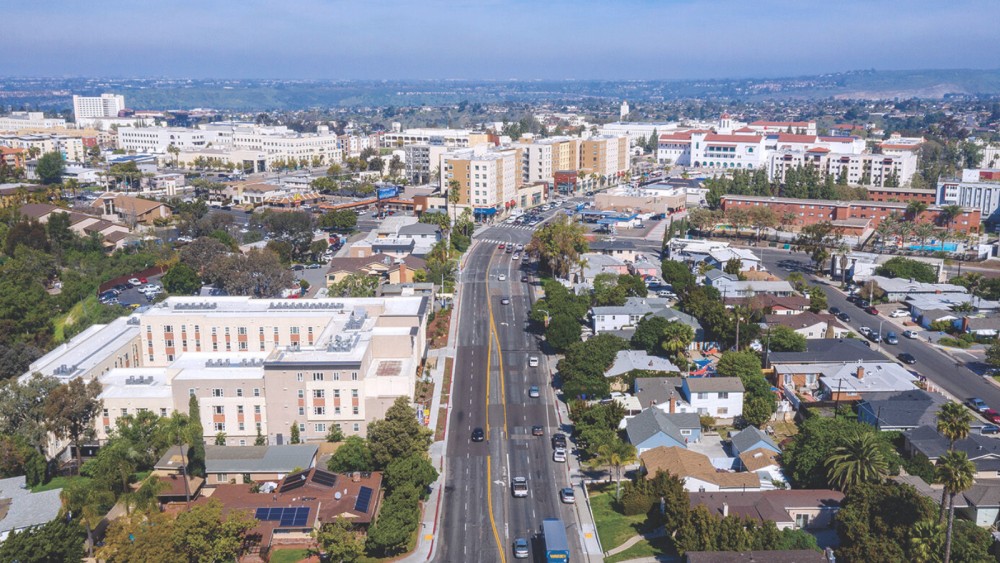In 2019, in anticipation of the city’s upcoming College Area Community Plan update, the College Area Community Planning Board began developing its own community-driven, 30-year growth strategy. The planning board believed that by demonstrating where new housing density could be placed to meet growth targets similar to those approved for other San Diego communities, the city would give strong consideration to its plan.
After a year of meetings and working groups, the board’s finished plan called for the creation of an urban village around San Diego State University (SDSU), adjacent to the campus trolley station. The vision included high-density housing along College Avenue, Montezuma Road, and other major thoroughfares with access to the existing bus system. The plan anticipated adding approximately 11,300 dwelling units to the current 8,100 units—a 137% increase—and boosting the area’s population by 112%, from 19,700 to 42,200. These increases align with recently approved community plan updates for Mira Mesa, Hillcrest, and Clairemont.
In 2020, the City Planning Department launched its formal, multi-year College Area Community Plan Update. Following an open house and initial comment period, the department presented four plan alternatives—but completely disregarded the College Area Community Planning Board’s earlier efforts.
The city’s current version of the community plan update calls for increasing the College Area’s population by nearly 300%, from 19,700 to over 74,000 people, with no major infrastructure improvements. The document glosses over the fact that many neighborhoods in the College Area are surrounded by canyons designated as very high-risk fire zones with limited evacuation routes. The city’s logic appears to be that heavy density in high fire risk areas somehow mitigates that risk.
This plan functions as an exercise in upzoning large portions of the College Area, leaving it to investors and developers to decide what gets built, when, and where. This is not strategic planning but rather an ad hoc, market-driven approach. Unfortunately, it will be taxpayers who are left footing the bill to address the aftermath.
One thing most people agree on is that SDSU is the center of the College Area community and impacts nearly everything that happens there. Given this, it’s incredible that the city did not include—or was unable to bring—SDSU into the planning process beyond perfunctory meeting attendance. None of the population projections account for SDSU’s own campus plans.
This raises a critical question: How can the city create a long-term community plan without the collaboration of its largest employer—an institution that houses and feeds thousands of students on campus, generates thousands of vehicle trips in and out of the community daily, and operates a major transit hub on campus?
If that isn’t problematic enough, the Metropolitan Transit System (MTS), which operates the trolley and buses tasked with moving many of these people, was also not involved. This is government dysfunction at its worst.
By failing to account for SDSU’s campus activities, the city’s plan cannot accurately forecast infrastructure needs for parks, roads, police, and fire services. And who will cover those costs?
Currently, SDSU is in the first phase of the Evolve student housing project at the northern end of campus. The site is three-quarters of a mile from the campus trolley station, located in a very high-risk fire zone, and lacks a pedestrian mobility plan for over 4,500 residents.
If the city, SDSU, MTS, and the College Area Community Planning Board were working together—leveraging hundreds of millions of dollars in state funding—SDSU could scale back the Evolve project in its current location and shift a significant portion of student housing to the asphalt parking lots along College Avenue adjacent to the trolley station. This would accelerate the creation of the urban village that the city claims to want—and that most people support.
Recently, the state legislature passed Senate Bill 79, which is expected to be signed by the governor. This bill calls for high-density housing within a quarter mile of mass transit stations. As a state university, SDSU provides even more reason to concentrate high-density student housing near the trolley station and to include this new law’s impact in the plan update.
Unfortunately, the city has chosen to rush its half-baked plan to the finish line, hoping the City Planning Commission will approve it on October 9 so the City Council can give its blessing in December.
It’s time for the city to pull back from its current plan update and collaborate with the College Area Community Planning Board, SDSU, and MTS to create a realistic, vibrant, and workable vision for the College Area—for today and tomorrow.
**Robert Montana** is chair of the College Area Community Planning Board.
**Rene Kaprielian** is a long-time resident of the College Area.
https://timesofsandiego.com/opinion/2025/09/26/unrealistic-plan-college-area-ignored-community-input/
